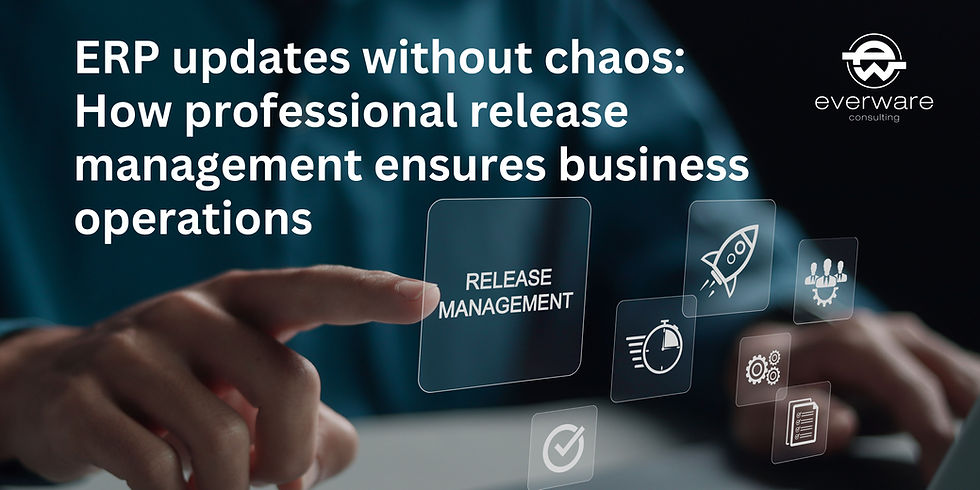ERP updates without chaos: How professional release management safeguards business operations
- sabineknoll3
- Oct 20
- 3 min read

Enterprise resource planning (ERP) systems orchestrate core processes ranging from financial accounting and logistics to human resources. This makes it clear that every update, every patch and every new version can have far-reaching effects on business operations. While new features and security updates are essential, ERP updates without a systematic approach harbour considerable risks. Chaos, production downtime and data inconsistencies are not uncommon.
This is where professional release management comes in: it structures, controls and monitors ERP updates so that innovations can be implemented without interrupting operations.
The complexity of ERP updates
ERP systems are highly integrated environments. Changes to one module can have unforeseen effects in other areas. Typical challenges include:
Process dependencies: An update in the finance module can, for example, affect automatic postings in warehouse management.
Interfaces to third-party systems: ERP systems rarely stand alone – they communicate with CRM, MES or e-commerce platforms. Every interface is a potential point of error.
Data integrity: Migrations and patches can compromise the consistency of historical data. This has a direct impact on reports, tax calculations and audit processes.
User acceptance: Even minor changes to interfaces or logic require training to prevent operating errors.
The bottom line: An ERP update is not a simple software patch – it is a change project that has a profound impact on the organisation.
Release management: The key to stable updates
Structured release management forms the methodological basis for successful ERP updates. Its goal is to roll out new versions in a controlled, repeatable and low-risk manner.
Core elements of professional release management
Element | Description | Benefit |
Change & risk analysis | Evaluation of affected modules, interfaces and processes | Early identification of critical paths, minimisation of surprises |
Test strategy & QA | Unit, integration and regression tests in sandbox environments | Ensuring functionality and data integrity |
Automation & DevOps principles | Automated deployments, CI/CD pipelines | Reduction of human error, faster rollout |
Rollback & contingency plans | Defined reset processes | Ensuring business continuity in the event of problems |
Communication & training | Informing IT, specialist departments and end users | Minimising operating errors and resistance |
Best practices for trouble-free ERP updates
Plan release cycles: Regular, minor updates are less risky than infrequent ‘big bang’ upgrades.
Use sandbox environments: Test real-life scenarios in advance to avoid surprises in the live system.
Monitoring after rollout: Closely monitor performance, interfaces and critical processes.
Change Advisory Board (CAB): An interdisciplinary committee prioritises changes according to business relevance.
Documentatioen & knowledge management: Document every adjustment in a traceable manner to quickly analyse the causes of errors.
Visual support for release management
A clear presentation is helpful. For example, a graphic could illustrate the typical release process.

Alternatively, or in addition, a table could summarise the risk factors for each module:
Module | Potential risks during update | Recommended measures |
Finance | Posting errors, inconsistencies | Regression tests, data backup |
Warehousing & logistics | Interface problems | Sandbox testing, process simulation |
Human resources | Compliance risks | Training, test data sets |
Sales & CRM | Workflow interruptions | End-to-end testing, CAB coordination |
Conclusion: Release management as a strategic success factor
ERP updates do not have to be chaotic. With professional release management, they become an instrument of stability and agility. Companies not only ensure the continuity of their core processes, but can also introduce new functions quickly and with low risk. Those who carefully plan, test, communicate and automate updates can turn a potentially dangerous change project into a competitive advantage.




Comments